Planting cabbage in open ground with seedlings
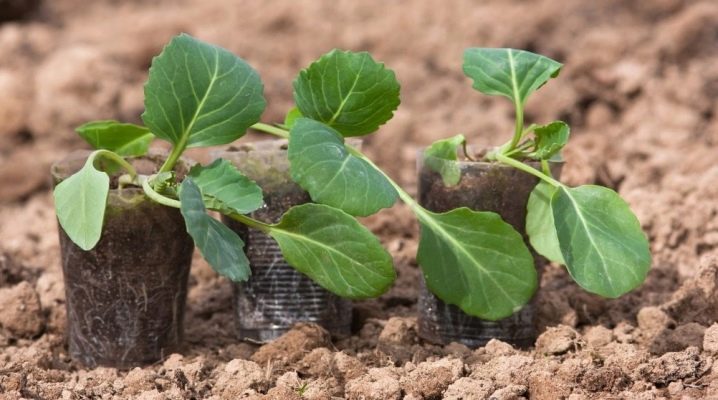
All types of cabbage are grown through seedlings. In order to get a rich harvest of vegetables, it is necessary, in strict accordance with agricultural technology, to transfer a young plant to open ground, and then properly care for it, preventing the attack of pests and the development of fungal infections.
Timing
Typically, cabbage seedlings are planted in open ground 50-60 days after planting the seeds. At that time, the plant should have at least 4 true leaves, best of all about 6-7. In this case, one should be guided by the temperature factor - it is possible to plant cabbage in the ground only after stable positive temperatures are established in the daytime and at night. If there is no opportunity to wait for favorable conditions or there is a high risk of recurrent frosts, then after transplanting it is necessary to equip a mini-greenhouse, that is, cover the seedlings with plastic wrap.
By this time, the earth should warm up to 10-15 degrees. Checking the readiness of the site is easy - just sit on the ground. If you feel comfortable without bedding, then cabbage seedlings will also like it there. Otherwise, it is better to wait a few more days.
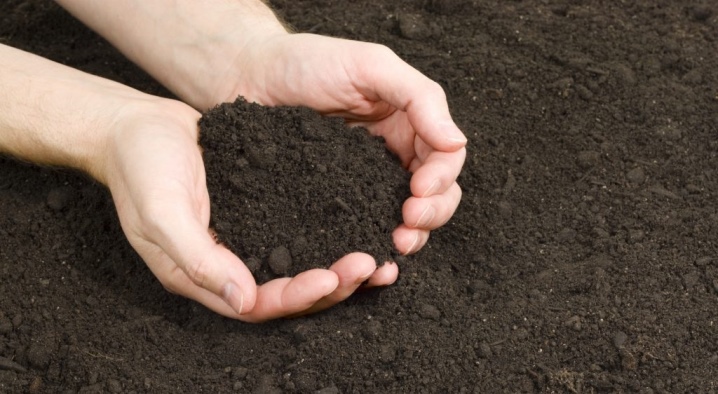
In central Russia, a transplant is carried out in the second half of May. In the southern territories, favorable conditions begin at the beginning of May. In Siberia and the northern regions, it is best to carry out these works in the first decade of June.
Many summer residents study the lunar calendar when choosing favorable days for planting cabbage. It is noticed that the cabbage crop, transplanted into the ground on the growing moon, grows and develops the fastest, the best grows and develops. If you adhere to this recommendation, then the plant will show resistance to diseases and insect pests.
The waning moon, as well as the periods of the new moon and full moon, are not favorable for cabbage.
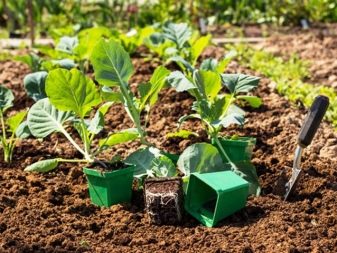
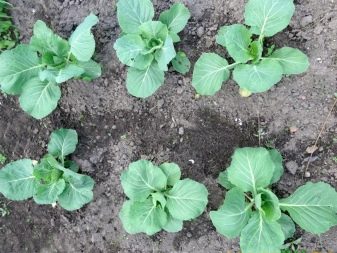
Preparation
An important role is played by the preparation of planting material and soil.
Seat selection
Cabbage of all varieties prefers an abundance of sun. Even the slightest darkening impairs the formation and ripening of fruits. Also, the vegetable does not accept weed congestion. Therefore, it is necessary for him to choose a site that is illuminated by the sun's rays throughout the daylight hours and on which weed perennials do not grow. The acceptable rate is 3 weeds per square meter of planting area.
The soil horizon is an important parameter. He must have a high or medium level of fertility.... If the selected area does not meet the specified criterion, then the situation must be corrected with the help of autumn and spring fertilization. Pay attention to the level of occurrence of groundwater - they should be at a depth of no more than 1 m from the surface of the ground.
The quality of growth and formation of fruits is affected by neighborhood... To increase yields, cabbage beds alternate with plantings of cucumbers, beans, spinach, lettuce, and potatoes. To repel insect pests in the aisles, you can plant plants with a pungent smell - celery, onions, dill, sage or marigolds. Some plants are completely incompatible with the cabbage crop due to the high risk of contracting the same infections. Peppers, parsley and tomatoes will become unlucky neighbors.

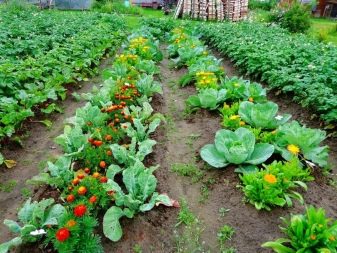
Crop rotation
When growing any crop, including cabbage, you must adhere to the rules of crop rotation. This allows the soil to retain the maximum set of trace elements necessary for the growth and development of plants and thereby ensures the rapid growth of the root system. In addition, such measures allow you to create additional protection for the plant from diseases and insect pests.
It is advisable to change the bed for cabbage every year, you can plant seedlings in the same place no earlier than after three seasons... If the sown area is limited and it is not possible to select another plot for cabbage, then immediately after harvesting or in early spring, it is advisable to sow green manures in the garden bed. It should be borne in mind that mustard is never used as a green manure for cabbage. Lupines and peas are the best precursors.
But it is undesirable to grow this plant after radish, turnip and radish.

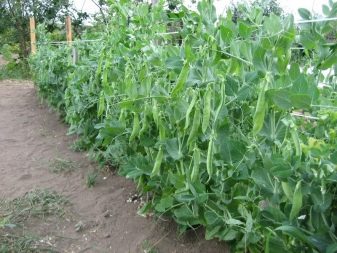
The soil
The preparation of the beds for planting cabbage should be done in advance, preferably in the fall. At this time, they dig up the earth to the depth of a shovel bayonet, remove the roots of weeds, debris and stones. Be sure to bring cow dung or bird droppings.
Spring preparation involves the formation of landing holes. Their depth should be 12-13 cm, slightly exceeding the length of the seedling root system. The planting scheme for most varieties of cabbage is 50x50. This plant does not like congestion, so the distance between individual bushes should be large enough for the crop to be fully sunlit and ventilated.
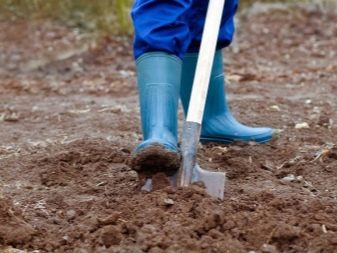
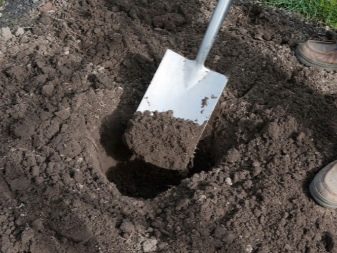
You need to prepare the holes 10 days before planting seedlings. Just before planting, a little wood ash is poured onto the bottom. A good result is obtained by applying a mixture of organic and mineral fertilizers. From mineral complexes, superphosphate is used at the rate of 15-20 g per well, compost is put from organic matter immediately before planting.
The easiest way is to feed immature plants with a mixture of wood ash and urea, 1 tbsp is added to one hole. l. each component... From "grandmother's" means, a mixture of dry mustard, crushed egg shells and ash, taken in equal proportions, works best. Shells and mustard protect against pests, while ash enriches the soil with potassium and reduces acidity.

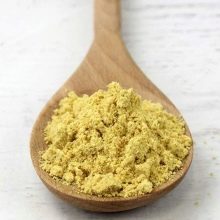
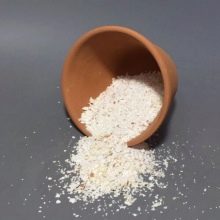
Planting material
4 days before planting seedlings, irrigation is removed as much as possible. In this case, it is important to ensure that the earthen lump does not dry out. 2 days before transplanting, it is necessary to feed young plants with a mixture of ammonium nitrate with superphosphate or Kemira Plus complex fertilizer. 4-5 hours before moving to open ground, the seedlings are watered abundantly - this will help to transfer them to a new place with minimal damage to fragile roots.
An important stage in preparing seedlings for transplanting into open ground is their hardening. This measure minimizes the risk of stress and improves adaptation at the new site. Hardening begins 10-14 days before transplanting. Its scheme is simple.
- Within 2-3 days, young plants are left in a room with an open window for 4-6 hours. At the same time, it is important to protect them from drafts.
- The next 3-4 days, boxes with seedlings are kept in any cool room.... For example, on a glazed loggia.
- As the ambient temperature drops reduce the amount of watering.
Starting from the 6th day, the seedlings are taken out to a balcony or street and left there until transplanting, gradually increasing the residence time from 1 hour to a day.
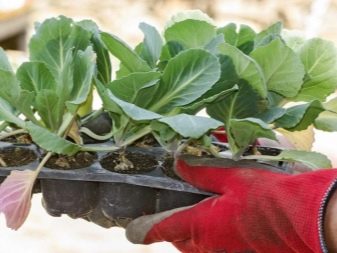
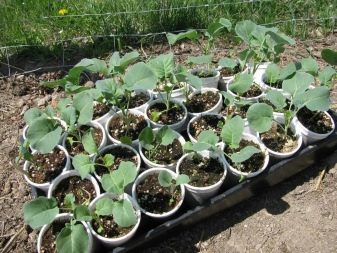
Landing technology
The technology of planting different types of cabbage has its own characteristics.
- White-headed... This cabbage is placed in holes 12 cm deep at a distance of 30 cm between the bushes. Be sure to apply fertilizer, consisting of 1 tbsp. tablespoons of wood ash and 300 gr. peat. Alternatively, you can take superphosphate, but only if the seedlings were not fertilized before replanting. About a liter of water is poured under each bush to the state of an earthen slurry.If it rains before planting and the soil is well moistened, then you can do without preliminary watering. Seedlings are planted so that the root collar is above ground level.
- Colored... The cauliflower planting scheme assumes a distance between individual bushes of 35-45 cm and a row spacing of 60 cm. This variety requires mandatory fertilization. The greatest effect is obtained by a mixture of chalk, superphosphate and ammonium sulfate, taken at 10-15 g per well. Cauliflower requires less water than white cabbage - 0.5-0.7 liters will be enough. In this case, planting is not carried out in a slurry, but only after the final absorption of all moisture into the ground.
- Kohlrabi... Cabbage of this variety is planted in accordance with the basic rules of agricultural technology. The only difference is feeding - this plant gratefully responds to the introduction of a mixture into the ground, consisting of 3 glasses of ash, 2 tbsp. l. superphosphate and 1 tsp. urea. Kohlrabi is planted in small holes, their depth should not exceed the size of the glass in which the seedlings were located. You can skip pre-watering. The seedlings are watered after the holes are covered with earth. It is very important not to deepen the root collar, since in this case the cabbage begins to bloom and stops growing.
- Broccoli... Planted according to the scheme - 45x60. The holes form shallow — the height of the landing hole should not be greater than the length of the cup. Broccoli do not like waterlogging, so pre-watering the wells is not necessary. For feeding, a mixture of compost and ash is added to each hole at the rate of 1 handful of each ingredient under a bush.
After planting, the seedlings are well watered, and the ground is covered with mulch to retain moisture.
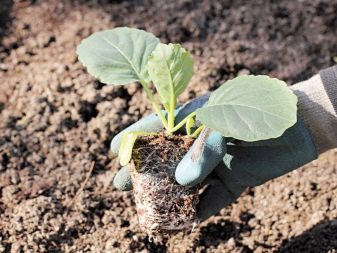
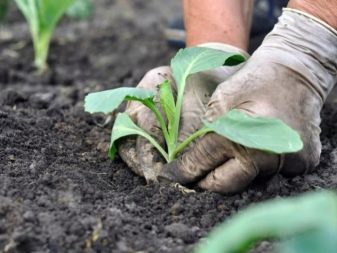
Follow-up care
Growing cabbage after transplanting seedlings into open ground is not particularly difficult. However, this plant requires compliance with all basic agricultural standards.
- Watering... All types of cabbage do not tolerate drought well, so they need frequent and abundant watering. Even a slight increase in ambient temperature causes a rapid loss of moisture. The optimal regime would be irrigation every 2-3 days in hot weather, and in cool watering it is reduced to 1 time per week. The volume of water directly depends on the size of the seedlings: plants just transplanted into the ground require 2 liters of moisture, adults need 2-3 times more.
- Loosening... The day after watering, the soil will crust over, especially in hot weather. At this moment, the soil should be loosened. Such treatment will allow to establish unimpeded air exchange in the root area.
- Top dressing... Growing cabbage of all types in the open field requires mandatory feeding. Usually fertilizer is applied twice - the first time 2 weeks after transplanting to a permanent site and the second time after another 10-14 days. Ready-made mineral complexes give the greatest effect. From folk remedies, a mixture of chicken manure and mullein or an infusion of herbs works best.

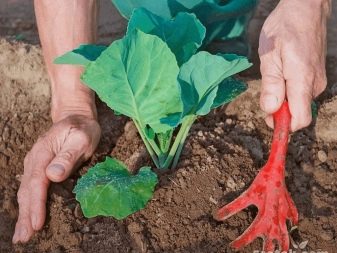
Representatives of the cruciferous family often suffer from pests, therefore, throughout the growing season, it is required to systematically fight against pathogens of fungal infections and insects.
Since a light waxy coating forms on cabbage leaves, to ensure maximum adhesion of the surface of the leaf plate with protective agents, it is advisable to add a soapy substance to the working solution - this can be specialized green soap or liquid household soap.
- For whitefly, whitefly and cruciferous flea the means "Atom", "Decis" and "Aktara" are working. Of the popular recipes, dusting with wood ash or tobacco dust is most effective.
- Deal with cabbage aphid pollination with tobacco or spraying with a solution of green soap at the rate of 250 g per liter of water will help. Treatment with the preparations "Dust Metaphos" or "Anabazin-sulfate" also saves.
- When a plant is damaged cabbage scoop in the early stages, you can dust the planting with ash. In case of a serious injury, insecticidal preparations "Sensei", "Borey" and "Altyn" help.
Yeast mash works against slugs and snails; it is prepared at the rate of 15 g of dry yeast and 250 g of sugar per 5 liters of water.

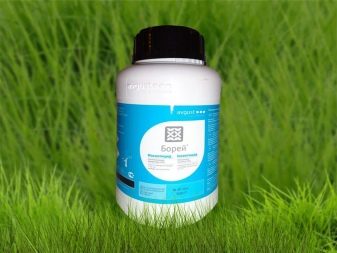
Of the diseases, cabbage is most often attacked by fungi.
- Powdery mildew. For spraying, copper-containing solutions are used, for example, copper sulfate or Bordeaux liquid.
- Blackleg. In this case, copper sulfate will also be effective; in case of serious damage, the fungicides "Fundazol" and "Planriz" will help.
- Keela... The treatment of the substrate with a light solution of potassium permanganate will help to save the plant.
- Fusarium, mosaic... Spillage of soil with 1% copper sulfate can help cabbage culture.
- Downy mildew... There is no cure for this disease. The only thing that gardeners can do is to strengthen preventive measures, in particular, to carry out pre-plant disinfection of seedlings.
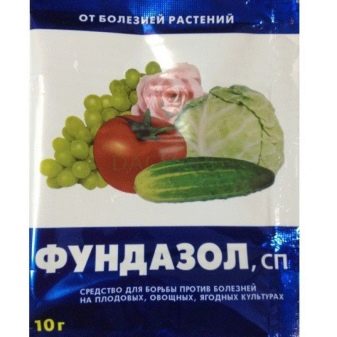
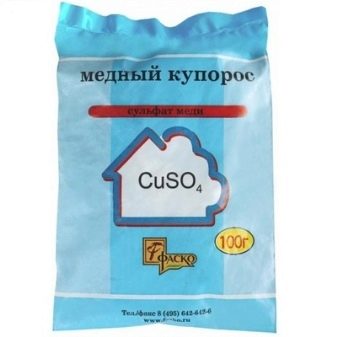
In order to minimize the risk of pest damage, it is necessary to monitor the degree of moisture, be sure to disinfect the seed, dive in a timely manner and transplant seedlings into the ground, and also maintain the temperature regime.
Possible mistakes
When growing cabbage, novice gardeners often make mistakes that can lead to the most unpleasant consequences, up to the death of cabbage seedlings. Therefore, in conclusion, we present the recommendations of experienced summer residents.
- To improve adaptation and accelerate the survival rate of cabbage seedlings, it is necessary to do two digging of the soil - autumn and spring, as a too dense substrate does not allow the roots to receive oxygen in sufficient quantities.
- If the seedlings are too weak, a mixture of 200-300 g of rotted manure and 30 g of monophosphate is placed on the bottom of the hole before planting... Sprinkle on top with soil and only after that place a young plant.
- The error is excessive moisture in the first week after transplanting seedlings into open ground. At this stage, it is better to water the soil more often, but in small portions.
- It is very important to choose the right area for cabbage, otherwise, the plants will slowly grow roots and develop poorly.
- Do not plant bushes too often., the minimum distance should be 30 cm. Otherwise, the plants will experience a lack of light, air and beneficial trace elements.
- Do not use well water for irrigation, as well as water supply. Be sure to defend it, as it may contain chlorine and other substances hazardous to cabbage. In addition, excessively cold moisture slows down the growth of the root system.
- Do not plant more than one bush in one hole.... The cabbage culture differs from all other vegetables in the size of the fruits, which, moreover, grow very quickly.
- If after transplanting the temperature dropped and the young seedlings froze, spray them with "Zircon" or any other growth stimulant.
- If the next day after moving the seedlings to the garden, the leaves become whitish, and the stem looks faded, don't worry. This is a natural reaction of an immature plant to changing habitat factors. To speed up recovery, you can spray the leaves with cool water early in the morning or in the evening after sunset.
- It would be a big mistake to ignore the rules of prevention of infections and attacks of insect pests.... Young plants have weak immunity, so they cannot resist pests on their own.
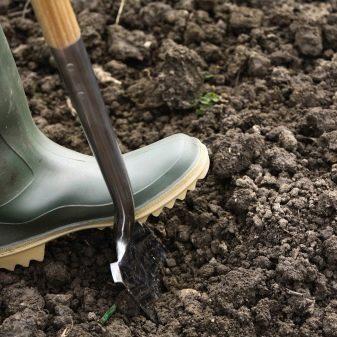
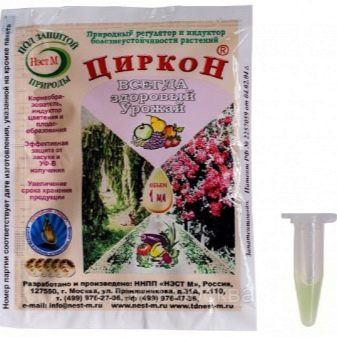
Having mastered all the intricacies of transplanting cabbage seedlings to open areas, you can get a healthy and bountiful harvest.
At the same time, one should not forget about proper care of the culture at the stage of fetal formation. Their resistance to adverse conditions, roundness and size of the heads largely depend on this.When growing cabbage, it is necessary to take into account the varietal characteristics and be guided by the requirements for agricultural technology of each specific type of cabbage.
It happens that the summer resident does not have time to transplant cabbage seedlings into the ground in a timely manner. In this case, young bushes weaken and begin to stretch out. Transplanting such crops has its own characteristics. In order for the plant to take root faster, it is necessary to arrange shock therapy for it.
- Immediately after removing the seedlings from the cups you need to cut the root in half, the holes are made 3 cm deeper than the earthen lump.
- Seedlings need to be planted up to the cotyledonous petals.
- There is no need to water, the ground after transplanting is only slightly moistened to prevent dryness... Such plants need to limit moisture. Only under these conditions do plants stop growing and direct their energies to growing full-fledged roots.
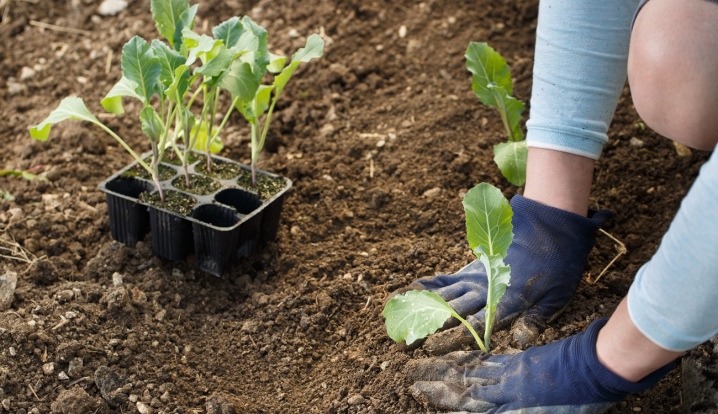










The comment was sent successfully.